
Hi Gang…
Cliff-diving Glasspar G2 body??? Who would have done such a thing? Why do such a demonstration?
I heard rumors of an article showing Glasspar G2 bodies being tossed off a cliff for years – but I never could find a copy or scent of any truth to the matter. Then I found an old Xerox of a few pictures confirming such an article existed – and a reference of Look Magazine, June 1954.
Joys of joy! I had found the article. Chance would happen that I was on my way to the Detroit Public Library and would have access to the right magazine and dates. But when I got there and pulled the magazines – no such article. So I pulled all of 1954 Look magazines – hours later – nothing to be found.
Where oh where could this missing article be?
Years later, I explained the conundrum to the right person – Alden Jewell – who immediately pulled the correct reference from his extensive library and index and voila…we have today’s article to share with all of you.
Alden….today’s story is dedicated to your wisdom, expertise, and research prowess. Way to go, and as always…..thanks for your help.
And now, for the article:
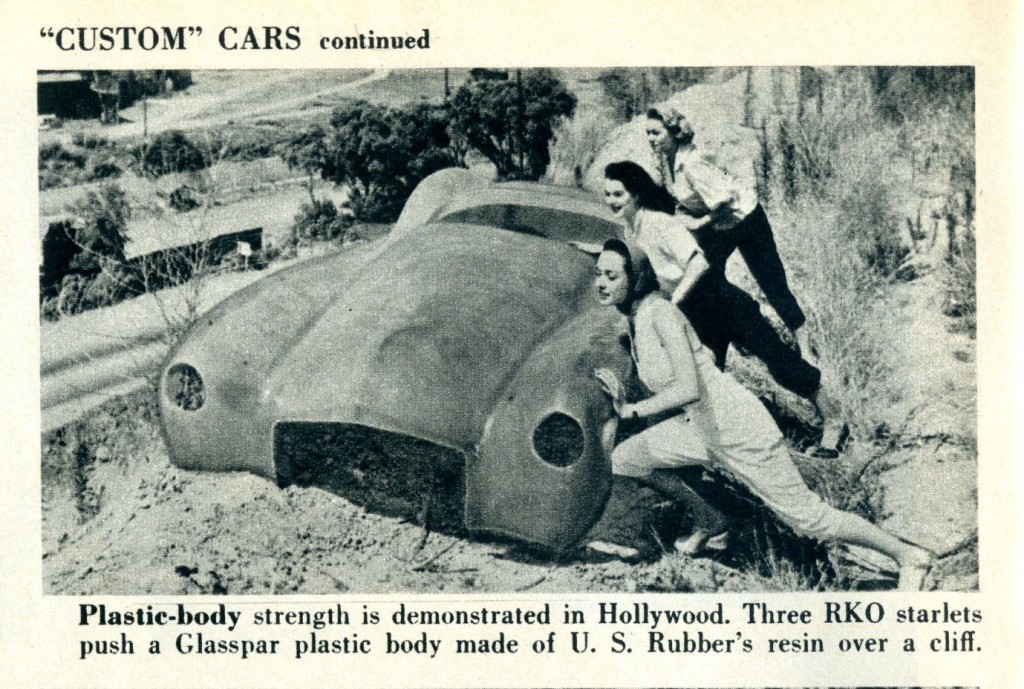
Caption: Plastic body strenth is demonstrated in Hollywood. Three RKO starlets push a Glasspar plastic body made of U.S. Rubber’s resin over a cliff.
Custom Cars For Everyone
Look Magazine: November 3rd, 1953
By George Koether (Look’s Automotive Editor)
Plastic-body autos are in limited production in Detroit. If the big companies learn how to make them in mass, every driver can have a car body built to his own specifications.
An industrial revolution is brewing in Detroit, a revolution that can bring you “custom” cars at moderate prices, with rust-proof, dent-proof, squeak-proof bodies. If motor makers learn to work with plastics as they have with steel – and there is every indication they will do so – the face of America’s largest manufacturing industry will be changed, and so will the faces of the cars it produces.
Today, to own a custom car, that is, one which differs in body design from Detroit’s standard, mass-produced package, you have to pay a whacking big premium for a special body from the factory, if you can get it. Or, you have to order a custom body from one of a dozen body builders who “lay up” plastic bodies by hand – a slow and costly process. As a compromise, you can “customize” your car by paying a custom shop to alter it in metal, also costly.
All that may be changed. The materials to change it are at hand, and the required machinery and methods are being worked out. Some engineers say the industry needs only a few years to develop the know-how to produce plastic-body cars in mass, at prices to make the process economically practical.
The revolution depends upon three developments:
- expanded use of plastic dies to replace steel dies
- perfection of glass-reinforced plastic to replace steel bodies, and
- “automation” – a technique to move parts into and out of production machines without being touched
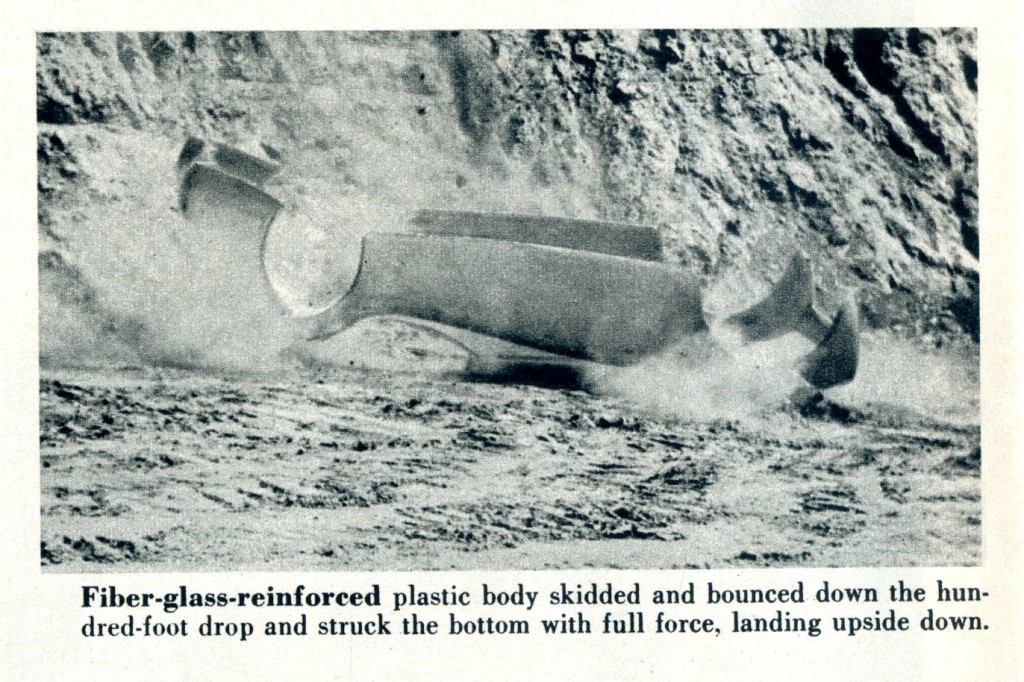
Caption: Fiberglass reinforced plastic body skidded and bounced down the hundred-foot drop and struck the bottom with full force, landing upside down.
If these three developments were incorporated in a bold new manufacturing program, the motor-car industry could be decentralized, with assembly plants building bodies as well as assembling them., and with hundreds of small body builders offering thousands of custom designs to a public becoming more and more “custom car” conscious. From the public’s point of view, the plastic body is enticing for more than its custom quality.
Fiberglass reinforced plastic bodies, weight for weight, are more resistant to impact than steel, do not need complicated subframes, have greater resiliency, will not corrode, and if chipped or scratched in collisions, can be repaired for a fraction of the cost of bumping out a steel fender or body panel.
Plastics are not new to the auto industry, they have been used for years in steering wheels, instrument panels, door handles and other small parts. But when auto makers studied a technique successfully in aircraft manufacture and began to use plastic dies, their eyes popped open.
Last fall, in the press plant of a “big three” auto maker, a steel fender die went bad. It was Friday afternoon. Over the weekend, a local die shop built a plastic die, and by Tuesday morning, the press was working and 1000 parts had been struck off the plastic die. (To make a steel die requires from four to six months.).
In another auto plant, a plastic die, used experimentally on a body-panel press, cracked when a steel bar fell between the punch and the die. Before the workmen at the press could put through a front-office order for a new die, a technician from the local die maker had arrived. Mixing a little powder with liquid, he patched up the die and had the press running in 45 minutes. Since then, more than 100,000 parts have been struck from the same plastic die.
Plastic dies are now accepted in the industry and Chrysler, Ford, and General Motors are working feverishly to beat each other to the tape in learning how to expand their use. GM’s Technical Center and Chrysler’s experimental plastic-die shop are cloaked in secrecy.
Regardless of how soon Detroit begins to mass-produce plastic bodies, plastic dies alone can radically alter manufacturing and marketing methods. The most costly and time-consuming part of auto making is the body. In fact, metal body dies are so costly that most car makers can afford a major change in body design only once every three years.
Plastic dies, which can cut the time for retooling by three quarters and the cost by two thirds, could permit new models oftener, and at a lower tooling cost. Using plastic dies to punch out steel bodies, motor makers can still offer a wider range of body types.
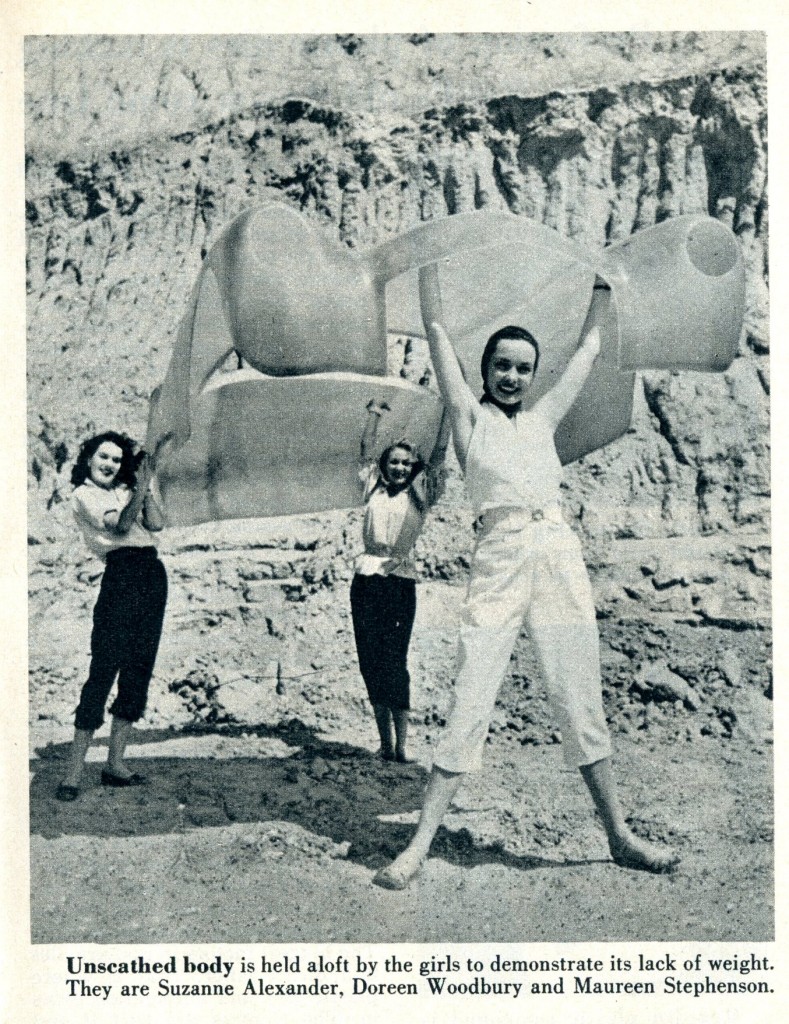
Caption: Unscathed body is held aloft by the girls to demonstrate its lack of weight. They are Suzanne Alexander, Doreen Woodbury, and Maureen Stephenson.
Plastics More Flexible:
The buyer appeal in automotive plastics, however, lies in the smooth, sleek designs which fiberglass makes possible. With plastics, contours are possible that cannot be achieved, practically, in steel. Small custom-body shops like Glasspar, in California, as well as giant General Motors began to move into the plastic-body market.
Early in 1953, for it Motorama show, General Motors gave its ace designer Harley Earl a free hand to show his stuff. Early’s styling section came up with four fiberglass plastic cars:
- Cadillac Le Mans
- Buick Wildcat
- Oldsmobile Starfire
- Chevrolet Corvette
The Corvette, engineered by Chevrolet’s Ed Cole, was the hit of the show. A Park Avenue gentleman with a mink-clad blonde on his arm surveyed the Corvette with detachment. “You can have it, darling,” the gentleman drawled, “if it’s not over ten thousand dollars.”
The Corvette, when available in quantity, will sell for $3250 f.o.b. Flint. Its cost delivered should be about $4,000. Production of the Corvette made history in the automobile industry. In less than a year, it came from the designers’ drawing board to delivery off the production line.
The first few bodies were hand-assembled by plastics experts at GM’s Tech Center under GM’s top engineer, Charlie Chayne. The 86 body, underbody and chassis dies and tools required to make it were produced in 10 weeks in plastic, instead of in the usual 18 months required with steel dies. And more than the Corvette’s sleek styling lies behind the fact that General Motors and other companies are taking plastic bodies seriously.
Last winter, a plastic-body experimental car was rounding a curve on the proving ground of one motor maker. The driver, seeking to avoid collision with a maintenance crew suddenly appeared on the highway, swerved off onto a soft shoulder, lost control of the car and rolled over three times.
When the car was turned upright, not a dent was found in the body. One engineer said that a similar accident in a steel-body car would have cost the driver his life. Chief bottleneck to mass production of plastic-body cars lies in the drying time required to harden the liquid resins which, reinforced with the fiber glass, comprise the body shell.
“You’d have to roof half the city of Detroit to build a plant big enough to mass-produce plastic-body cars today,” says one chemist. “Detroit is interested in parts per minute, not hours per part.”
But plastic makers say they have fast-setting resins now available which, if produced in quantity could be reduced in cost to make mass production feasible. In any case, a year or two would be needed to build the resin production capacity to supply the automotive industry. True, plastic bodies can be made with steel dies, but “curing time” would still be a problem.
The real revolution will come when someone manages to punch plastic body parts from plastic dies without any time taken for “curing.” Detroit auto makers are hesitant to admit that this process is in prospect, but some shops are working on the problem.
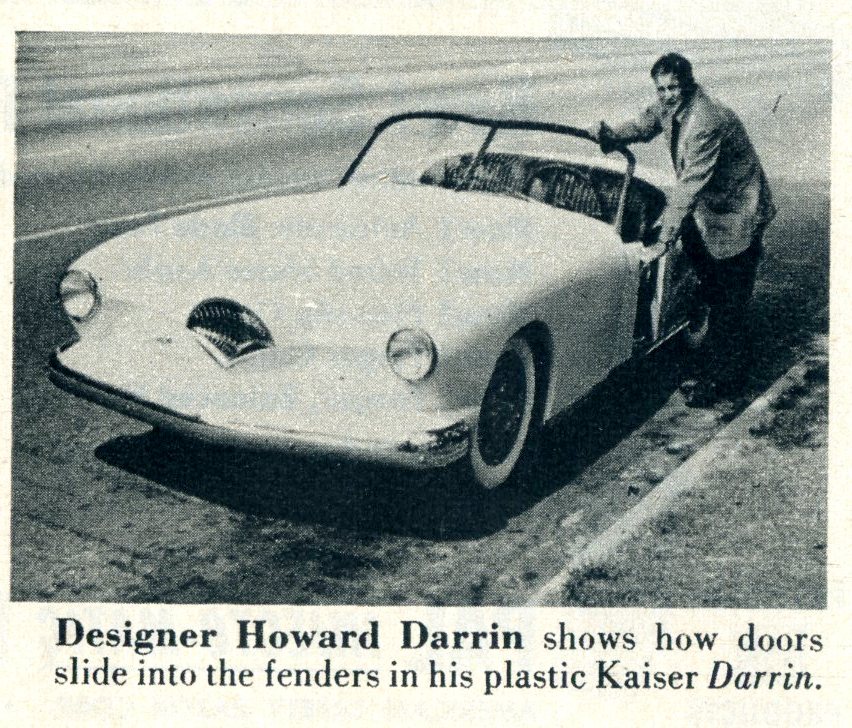
Caption: Designer Howard Darrin shows how doors slide into the fenders in his plastic Kaiser Darrin.
Pressing Out Parts:
One plastic maker envisages replacing Detroit’s huge, costly, metal-stamping presses with a battery of machines as simple as a row of pants pressers. By “automation” (as V-8 engines now are made in Ford’s “automatic” factory in Cleveland), fiberglass mats, preformed in the shape of fenders and body panels, and impregnated with quick-setting resins, would move automatically into the rows of “pants pressers.”
Body parts would be pressed out as quickly and as easily as a suit of clothes – with little head and only slight pressure needed to form the panels and fenders. Another plastic maker sees a rebirth of small body businesses all over the country.
“The small automobile company is again a possibility,” he contents. As he sees it, several custom-body makers can set up shop using plastic dies, pressing out a myriad of body designs to fit the chassis made in Detroit. One such company in Massachusetts is now supplying plastic bodies to fit every Ford or Mercury chassis simply by changing the size of the doors.
If plastic bodies become standard on Detroit cars, then a bonanza may await small accessory firms who can supply variant designs for plastic front ends, fenders, and rear-deck extensions to “customize” cars at a much lower price than they now can using steel.
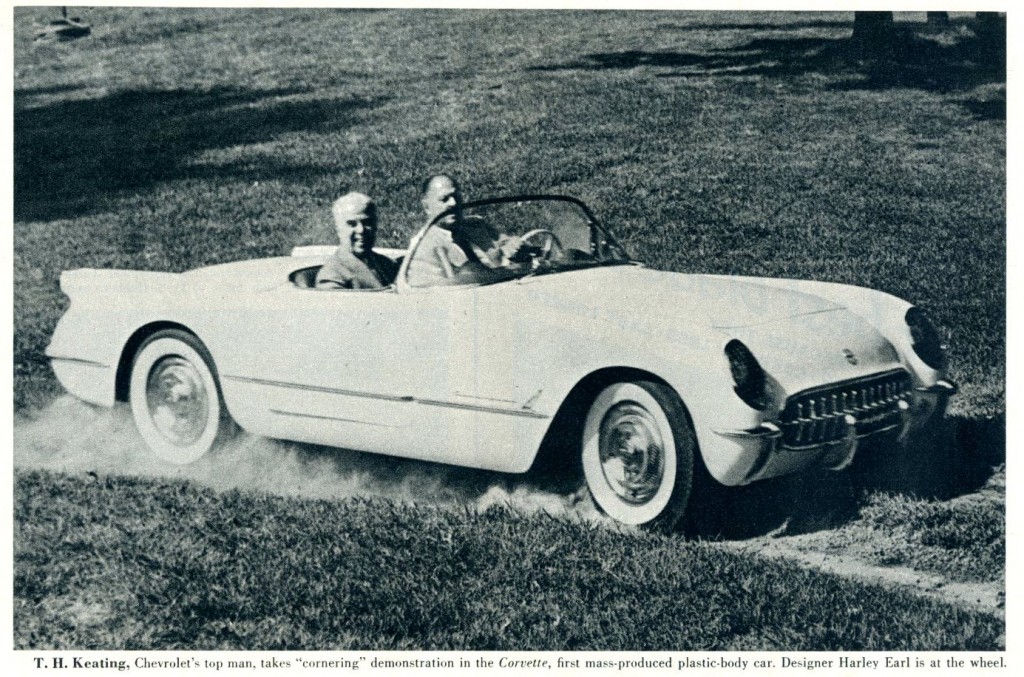
Caption: T.H. Keating, Chevrolet’s top man, takes “cornering” demonstration in the Corvette, first mass-produced plastic-body car. Designer Harley Earl is at the wheel.
The Key: Dies and Automation
What of the steel makers? Are they worrying over this portending revolution? Not yet. Steel capacity is up. No one, at present, can see plastic competing with steel on a cost basis. But steel itself isn’t much of a cost factor in an automobile. In a car retailing at $1984, the steel component amounts to $225.
The biggest factors in cost are dies and direct labor. That is where plastic dies and automation come in. The chances are that if and when plastic-body cars are made in quantity, they will have to compete for some time with steels cars.
As consumers indicate their preference, the manufacturing process will adjust to the market. In any case, you’ll have to go without a car for a few years if you wait for plastic bodies in volume. Meanwhile, Detroit is producing some gleaming new steel beauties.
But as as you watch your wife (or yourself) crumple that fender backing into a lamp post, and painfully contemplate the coming repair bill, you can dream of the day when your plastic-body car can be patched by Junior, working with a little powder and liquid.
And you can look forward to the day when your squeak-proof, dent-proof, rust-proof, automobile (even the frame and bumper could be plastic) won’t look too much like many other cars on the road – if any.
Summary:
This was one serious article on fiberglass, gang.
Although the pictures of the G2 bodies were neat to find, the most important issue discussed was how “fiberglass” was going to change the nature of materials used in the automotive industry – and the industry along with it. Pretty heady stuff here – the sky seemed the limit for our favorite “glass guys” of yore.
And I wonder what “body company” they were talking about in Massachusetts “now supplying plastic bodies to fit every Ford or Mercury chassis simply by changing the size of the doors?” I have found companies in New York, New Jersey, and even more recently in Rhode Island. Nothing in Massachusetts so far in 1952 or years beyond. As always, research continues….let us know what you know, if “Massachusetts” rings a bell.
Oh…and one last thing for you “Glasspar G2 owners” out there….one of you probably has this body on their vintage G2 today. Is this your car in the article?
Only the “fiberglass” shadow knows…. 😉
Hope you enjoyed the story, and until next time…
Glass on gang…
Geoff
——————————————————————-
Click on the Images Below to View Larger Pictures
——————————————————————-
- Caption: T.H. Keating, Chevrolet’s top man, takes “cornering” demonstration in the Corvette, first mass-produced plastic-body car. Designer Harley Earl is at the wheel.
- Caption: Glasspar built this experimental plastic body for U.S. Rubber, whose resin was used in it.
- Caption: Designer Howard Darrin shows how doors slide into the fenders in his plastic Kaiser Darrin.
- Caption: Plastic body strenth is demonstrated in Hollywood. Three RKO starlets push a Glasspar plastic body made of U.S. Rubber’s resin over a cliff.
- Caption: Fiberglass reinforced plastic body skidded and bounced down the hundred-foot drop and struck the bottom with full force, landing upside down.
- Caption: Unscathed body is held aloft by the girls to demonstrate its lack of weight. They are Suzanne Alexander, Doreen Woodbury, and Maureen Stephenson.
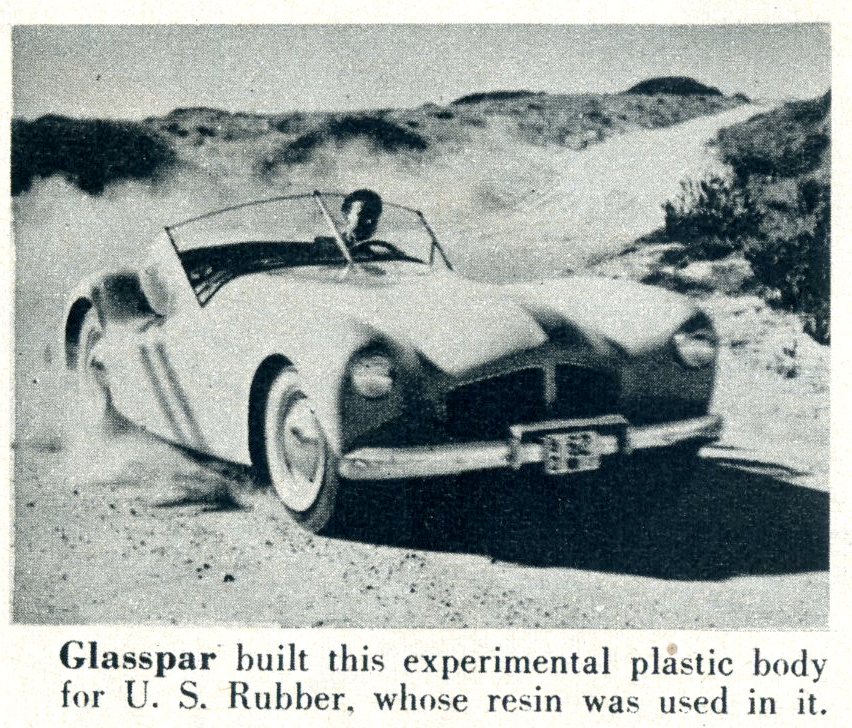





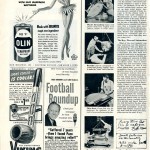

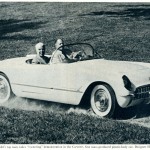
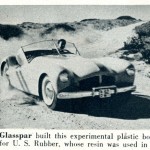
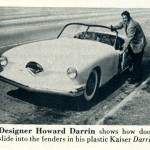

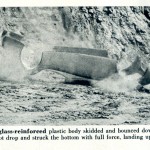


The info was very well put. I was building and repairing with resigns and cloth in the 60s ,found more uses for it than a barrel of monkeys . Now this carbon fiber is even better!Still a bit costly though!
Bill Tritt , told me years ago that a glasspar was featured in look magizine ,I had found the Life magizine artical, and I had a copy of one picture of the girls pushing the body off the cliff from one of the early club members, but didn’t know where it came from, I could never find it!. My thanks to Alden Jewell and Geoff for solving this mystery!
Early polyester based fiberglass was an amazing product, but today it is even more remarkable with so many advances, pre preg, carbon fiber kevlar, epoxie’s. and more, even polyester resin is available in many different formulations from fairly basic to vinyl ester. Technology that allows for fully cured parts ready to de-mold in around 30 minutes with vacuum bag technology, even injection molding fiberglass too. Even SMC which made a huge appearance in the 70’s on many production cars. (Not one off my favorite inventions, but still an amazing technological advance) that yielded high precision parts for header panels and the like.
Like the old cigarette adds used to say, we’ve come a long way baby. Not only the resins and structural agents but super light strength agents phenolic coated paper, coremats, and a wide range of other products that have changed the face of fiberglass and how it is produced. All for the better.
Would be neat to see the same test done on some of the modern products. I am sure the results would be impressive. Even lighter and stronger. Of course more expensive to produce than open mold wet lay up glass of the day when the Glasspar was made.
Might be fun to explore the various techniques used to make bodies over the years.